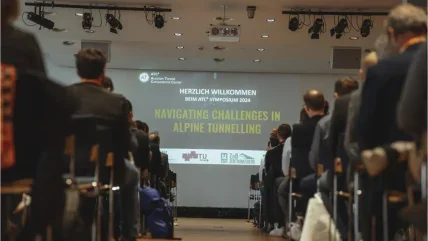
Challenges in alpine tunnel engineering, with a special focus on complex projects in demanding geological conditions in alpine terrain, were a special focus of the ATC2 Symposium in Innsbruck on November 14
Throughout the day, experts highlighted innovations in TBM design, emphasising improved cutterhead performance; discussed the role of the construction site manager; and presented breakthroughs in slurry microtunnelling technology for hard rock environments or in automation of the application of shotcrete.
A significant theme of the symposium was the growing role of Tunnel Information Modelling (TIM) in modern tunnelling projects. Presentations demonstrated its practical applications in preliminary designs, such as the Dresden-Prague Ore Mountains tunnel, and in the digital documentation of Austrian railway tunnels. These examples illustrated how TIM is transforming both planning and execution phases, enhancing accuracy and efficiency.
Discussions also addressed the evolving contractual and operational challenges in large-scale tunnelling, particularly in alpine and geologically complex regions. Next year, for example Italy is set to launch as many tunnelling projects as are normally launched in the rest of Europe combined, raising concerns about a potential shortage of expertise and skilled professionals for these ambitious undertakings.
Case studies, including the Lyon-Turin project, offered valuable lessons on overcoming design difficulties and managing the uncertainties of such environments. Innovative applications, like the use of fibre optic sensors in the Kühtai power station, showcased how cutting-edge technologies are improving monitoring and performance in alpine tunnelling.
The event concluded with a discussion emphasising that the future of tunnelling lies in continuous technological advancement, digital transformation, and co-operation between science and industry.
Next year’s event will be held in Leoben.







